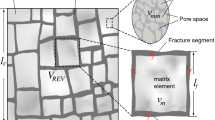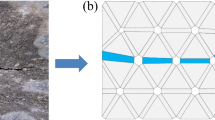Abstract
Based on the characteristics of fractures in naturally fractured reservoir and a discrete-fracture model, a fracture network numerical well test model is developed. Bottom hole pressure response curves and the pressure field are obtained by solving the model equations with the finite-element method. By analyzing bottom hole pressure curves and the fluid flow in the pressure field, seven flow stages can be recognized on the curves. An upscaling method is developed to compare with the dual-porosity model (DPM). The comparisons results show that the DPM overestimates the inter-porosity coefficient λ and the storage factor ω. The analysis results show that fracture conductivity plays a leading role in the fluid flow. Matrix permeability influences the beginning time of flow from the matrix to fractures. Fractures density is another important parameter controlling the flow. The fracture linear flow is hidden under the large fracture density. The pressure propagation is slower in the direction of larger fracture density.
Similar content being viewed by others
References
Barenblatt, G. I., Zheltov, I. P., and Kochina, I. N. Basic concepts in the theory of seepage of homogeneous liquids in fissured rocks [strata]. Journal of Applied Mathematics and Mechanics, 24(5), 1286–1303 (1960)
Warren, J. E. and Root, P. J. The behavior of naturally fractured reservoirs. Society of Petroleum Engineers Journal, 3(3), 245–255 (1963)
Kazemi, H. Pressure transient analysis of naturally fractured reservoirs with uniform fracture distribution. Society of Petroleum Engineers Journal, 9(4), 451–462 (1969)
De Swaan, O. A. Analytic solutions for determining naturally fractured reservoir properties by well testing. Society of Petroleum Engineers Journal, 16(3), 117–122 (1976)
Kazemi, H. and Gilman, J. R. Multiphase flow in fractured petroleum reservoirs. Flow and Contaminant Transport in Fractured Rock, 31(91), 267–323 (1993)
Thomas, L. K., Dixon, T. N., and Pierson, R. G. Fractured reservoir simulation. Society of Petroleum Engineers Journal, 23(1), 42–54 (1983)
Coats, K. H. Implicit compositional simulation of single-porosity and dual porosity reservoirs. SPE Symposium on Reservoir Simulation, Society of Petroleum Engineers, Houston (1989)
Ueda, Y., Murata, S., Watanabe, Y., and Fanatsu, K. Investigation of the shape factor used in the dual-porosity reservoir simulator. SPE Asia-Pacific Conference, Society of Petroleum Engineers, Sydney (1989)
Zimmerman, R. W., Chen, G., Hadgu, T., and Bodvarsson, G. S. A numerical dual-porosity model with semi-analytical treatment of fracture/matrix flow. Water Resources Research, 29(7), 2127–2137 (1993)
Chang, M. M. Analytical Solution to Single and Two-Phase Flow Problems of Naturally Fractured Reservoirs: Theoretical Shape Factor and Transfer Functions, Ph. D. dissertation, University of Tulsa (1995)
Quintard, M. and Whitaker, S. Transport in chemically and mechanically heterogeneous porous media I: theoretical development of region-averaged equations for slightly compressible singlephase flow. Advances in Water Resources, 19(1), 29–47 (1996)
Ranjbar, E. and Hassanzadeh, H. Matrix-fracture transfer shape factor for modeling flow of a compressible fluid in dual-porosity media. Advances in Water Resources, 34(1), 627–639 (2011)
Hassanzadeh, H. and Pooladi-Darvish, M. Effects of fracture boundary conditions on matrixfracture transfer shape factor. Transport in Porous Media, 64(1), 51–71 (2006)
Noorishad, J. and Mehran, M. An upstream finite element method for solution of transient transport equation in fractured porous media. Water Resources Research, 3(18), 588–596 (1982)
Baca, R. G., Arnett, R. C., and Langford, D. W. Modeling fluid flow in fractured-porous rock masses by finite-element techniques. International Journal of Methods in Fluids, 4(4), 337–348 (1984)
Kim, J. G. and Deo, M. D. Comparison of the performance of a discrete fracture multiphase model with those using conventional methods. SPE Symposium on Reservoir Simulation, Society of Petroleum Engineers, Houston (1999)
Hoteit, H. and Firoozabadi, A. Compositional modeling by the combined discontinuous Galerkin and mixed methods. Society of Petroleum Engineers Journal, 11(1), 19–24 (2006)
Zhang, D. M., Cai, C. X., Zhang, K. B., Zhan, J. M., and Huang, H. Computational Fluid Mechanics (in Chinese), Sun Yat-sen University Press, Guangzhou (1991)
Cinco-Ley, H. and Samaniego-V, F. Fractured reservoir simulation. Society of Petroleum Engineers Journal, 33(09), 1749–1766 (1981)
Noetinger, B. and Estebenet, T. Up-scaling of double porosity fractured media using continuoustime random walks methods. Transport in Porous Media, 39(1), 315–337 (2000)
Bourdet, D. Well Test Analysis: The Use of Advanced Interpretation Models, Elsevier, Amaterdam, 63–65 (2002)
Author information
Authors and Affiliations
Corresponding author
Additional information
Project supported by the National Natural Science Foundation of China (No. 5140232), the National Science and Technology Major Project (No. 2011ZX05038003), and the China Postdoctoral Science Foundation (No. 2014M561074)
Rights and permissions
About this article
Cite this article
Wan, Y., Liu, Y., Ouyang, W. et al. Numerical investigation of dual-porosity model with transient transfer function based on discrete-fracture model. Appl. Math. Mech.-Engl. Ed. 37, 611–626 (2016). https://doi.org/10.1007/s10483-016-2075-8
Received:
Revised:
Published:
Issue Date:
DOI: https://doi.org/10.1007/s10483-016-2075-8
Key words
- dual-porosity model (DPM)
- discrete-fracture model
- fracture network
- finite-element method
- upscaling
- numerical well test




